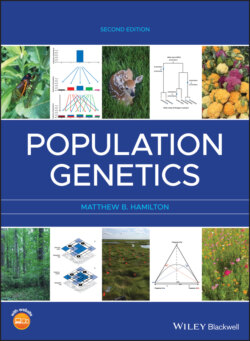Читать книгу Population Genetics - Matthew B. Hamilton - Страница 44
Physical linkage
ОглавлениеLinkage is the physical association of loci on a chromosome that causes alleles at the loci to be inherited in their original combinations. This association of alleles at loci on the same chromosome is broken down by crossing over and recombination. The probability that a recombination event occurs between two loci is a function of the distance along the chromosome between two loci. Loci that are very far apart (or on separate chromosomes) have recombination rates approaching 50% and are said to be unlinked. Loci located very near each other on the same chromosome might have recombination rates of 5 or 1% and would be described as tightly linked. Therefore, the degree of physical linkage of loci dictates the recombination rate and thereby the decay of gametic disequilibrium. Genome locations are often mapped in terms of their recombination frequencies with the measure centimorgan (abbreviated cM) or map unit (m.u.) where 1 cM is equivalent to a 1% recombination rate under a model that corrects for multiple crossovers called Haldane's map function (see Casares 2007).
Linkage‐like effects can be seen in some chromosomes and genomes where gametic disequilibrium is expected to persist over longer time scales due to exceptional inheritance or recombination patterns. Organisms such as birds and primates have chromosomal sex determination, with the well‐known X and Y sex chromosome system in humans. Loci located on X chromosomes experience recombination, whereas those on Y chromosomes experience no recombination. This is caused by the Y chromosome lacking a homologous chromosome to pair with at meiosis since YY genotypes do not exist. In addition, we would expect that the rate of decay of gametic disequilibrium for X chromosomes is about half that of autosomes with comparable recombination rates, since X recombination takes place only in females (XX) at meiosis, and not at all in males (XY). Organelle genomes found in mitochondria and chloroplasts are a case where gametic disequilibrium persists indefinitely since these genomes are uniparentally inherited and do not experience observable levels of recombination. There is variation in the rate of recombination among species, within and among populations and between sexes (Stapley et al. 2017), with “hotspots” that show elevated rates as well as areas of restricted recombination such that genomes may have marked heterogeneity in recombination rates. In humans, for example, patterns of haplotype polymorphism suggest that about 80% of all recombination events take place in a subset of only about 15% of the genome (Myers et al. 2006).
